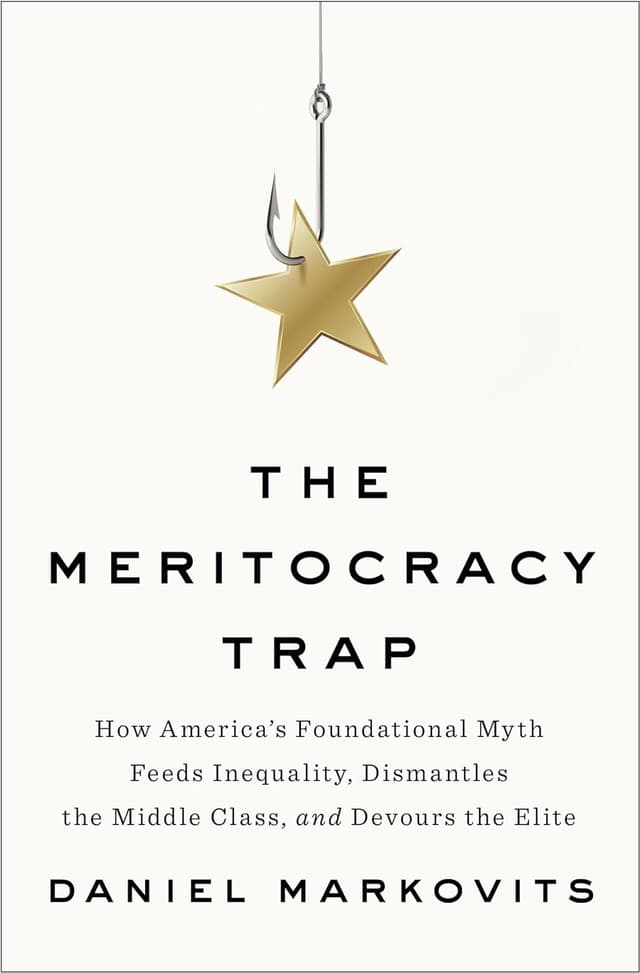Felix Salmon | October 9, 2019
Why is this interesting? - The Pop Art Edition
On art, auctions, and the mainstreaming of expensive art
Recommended Products

Daniel Markovits's commencement speech at Yale Law School, which critiques the meritocracy system, turned into a book.
Felix Salmon (FMS) joins us for a second WITI today. He previously wrote about the Sackler family and philanthropy for WITI 5/17. You can find him regularly over at Axios and his Sunday business and finance email Axios Edge. - Noah (NRB)
Felix here. A few auction records have been shattered recently. In April, “The Kaws Album” by KAWS sold for HK$116 million at Sotheby’s in Hong Kong, or $14.7 million. Then “Devolved Parliament” by Banksy sold for £9.9 million, or $12.2 million, a few days ago at Sotheby’s in London. Finally Yoshitomo Nara’s “Knife Behind Back” sold for HK$196 million, or $25 million, again at Sotheby’s in Hong Kong. (The previous auction records for KAWS, Banksy, and Nara: $2.7 million, $1.9 million, and $4.5 million, respectively; what’s more, the Banksy was a collaboration with Damien Hirst.)
Why is this interesting?
Art-world types will immediately notice that all three sales happened at Sotheby’s, which has in recent years been playing second fiddle to its archrival Christie’s. What’s more, they took place not in New York, the center of the art-auction world, but in Hong Kong and London.
Art-world types will also generally sneer at the people paying these record prices, saying that these paintings barely count as art in the first place, let alone art worth 8-figure sums. “The Kaws Album” and “Devolved Parliament” are not-very-funny one-note jokes, while “Knife Behind Back” is an oversized cartoon figure.

So, what’s going on? Why are these artworks so expensive? Part of the reason is relatively mundane: All 3 canvases are old-fashioned paintings, and all of them are unusually large. In the art world, size matters, and paintings have had primacy for centuries. (They’re relatively easy to store and display, they meet your walls’ need to be filled, and works on paper are fragile, discoloring in the sun.)
At the same time, collectors have always collected the art that they love. These artists have large fan bases, and the top 0.01% of those fan bases will want to own strikingly large unique works. All you need is 2 rich collectors duking it out in an auction room for a single piece, and a crazy new record is set.
There’s something else going on, though, which is the way in which the collectors are surely congratulating themselves right now for being ahead of the curve. For well over 100 years, art collectors have embraced the tradition of the “avant-garde”—the idea that their ahead-of-the-curve eye can identify artists doing something dangerously new, something that’s hard for the old guard to understand and appreciate. Didn’t the academicians sneer at Duchamp and Basquiat, just as the self-proclaimed art-world elite are sneering at KAWS?
The irony is that each successive generation of artists has in many ways become easier to understand and appreciate. Try to unpack the layers and craftmanship in “Las Meninas” by Velazquez, then look at, say, “The Dance” by Matisse. The “difficulty level” has clearly gone down, not up. Then fast forward to Pollock’s drip paintings, Warhol’s Marilyns, and finally the cartoonish stylings of Koons and Murakami. Each is simpler, more universal, more easily grokked, more exportable than the last. You need less and less specific cultural context or connoisseurship to appreciate these works.
Not all art has gone pop, of course: There’s a strong countertrend of art becoming ever more hermetic and accessible only to the cognoscenti, that goes back at least as far as Duchamp and Beuys. But the minimum level of sophistication that an artwork needs in order to fetch 8 figures at auction has clearly been falling as the world of art collectors has expanded and globalized. (FMS)
Comic of the Day:
XKCD’s map of mobile phone functionality. True story: A few years ago I was on a plane and I saw a guy open a briefcase only to pull out a tape player, map, book, notebook, and pen. I was impressed. (NRB)

Quick Links:
David Foster Wallace partisans be damned. There is only one good commencement speech, and it’s this one, from Yale Law School professor Daniel Markovits. He recently turned it into a very long book, but the substance of the book is all here. (FMS)
The Christmas Sermon 2012 – “On Not Believing In Canada” (FMS)
Since Felix is our guest today it seems worth pointing to one of his favorite pieces in case you’ve never read it. Money is Memory basically posits that “from a technological point of view, money is equivalent to a primitive form of memory.” (NRB)
Thanks for reading,
Noah (NRB) & Colin (CJN) & Felix (FMS)
Why is this interesting? is a daily email from Noah Brier & Colin Nagy (and friends!) about interesting things. If you’ve enjoyed this edition, please consider forwarding it to a friend. If you’re reading it for the first time, consider subscribing (it’s free!).